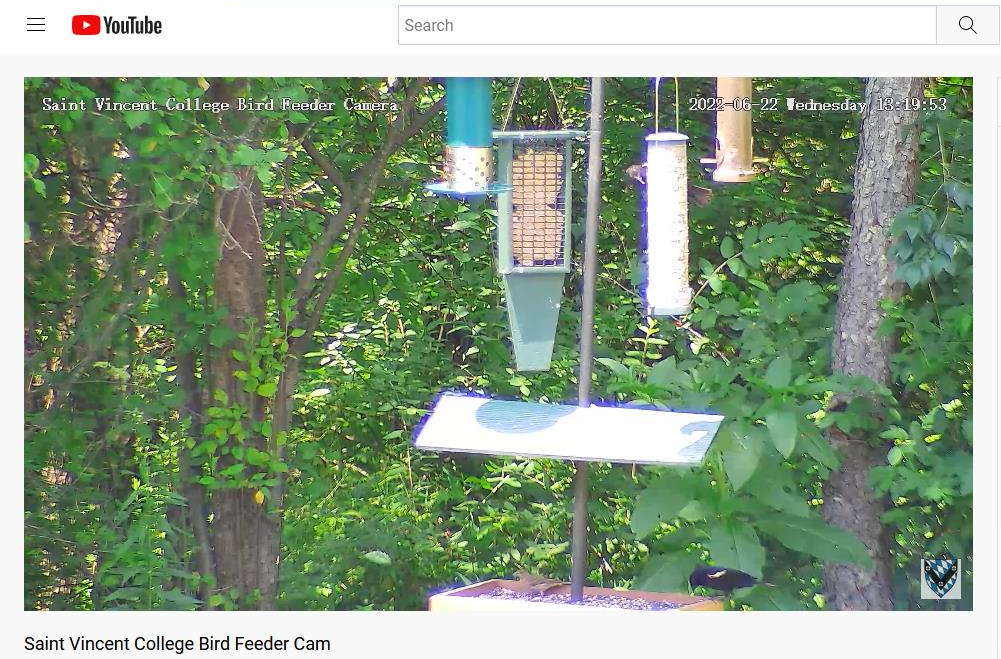Together, We Succeed.
Introducing Saint Vincent College’s new birdfeeder webcam: what’s its purpose?

I’m truly excited to announce a collaboration between PixCams, Inc., the Department of Biology at Saint Vincent College and Winnie Palmer Nature Reserve (WPNR) that has resulted in the installation of a live-stream webcam that will show bird activity at the bird feeding stations at WPNR. For now, the livestream can be found on YouTube at this link, but it will soon be available on the PixCams and WPNR websites.
Why is this so exciting? I can name four reasons!
First, I use bird feeder webcams at other locations (PixCams has several to choose from) for instructional purposes. I assign students activities for which they have to identify the species that come to the bird feeders and then note dominance interactions between them. The students enjoy this, but I think they’ll enjoy it even more when they know the live feed they are watching is originating here on campus.
Second, the bird feeder webcam may be used by senior biology or environmental science majors conducting their thesis research projects. A former student of mine who graduated in spring 2021 watched the bird feeders at WPNR in person and evaluated relationships among such variables as weather conditions, the frequency of visits by the various species, their aggressive interactions and their flock sizes. He did this in the middle of winter, and there were snowy days when he couldn’t drive to the site. My student is now enrolled as a doctoral candidate in the biological sciences program at Duquesne University. As I think back among my other 66 former research students over the last 15 years at Saint Vincent, I know several others who would have benefitted from this system.
Third, the bird feeder webcam is for public outreach and some publicity. We are a Benedictine college with a tradition of humility; however, when we have something special to offer our students and members of the community, it’s important to publicize it. Winnie Palmer Nature Reserve is a 50-acre gem nestled in the Laurel Highlands of Pennsylvania that serves as a place to find solitude, learn about nature and spot some native plants and animals. Maybe if people find our webcam on the internet (and based on the success of PixCams, they will), it will give them an excuse to come visit the Reserve in person. And when people visit WPNR, they’ll see the buildings of Saint Vincent College nearby and they’ll be curious about us, too.
Finally—and most importantly—the bird feeder webcam will draw people in to foster appreciation for birds and care for the Earth. A donor to our program asked me what could be done to promote ornithology. One of my first thoughts was this webcam. Let me explain by telling you about a small aquarium near the front entrance of our Dupré Science Pavilion: there is almost always a student or faculty member standing in front of it every time I pass. As fish do their gymnastics within the close confines of glass walls, people just can’t stop watching. I think if people have a convenient way to see what’s going on at a birdfeeder, they’ll be just as mesmerized, and I have personal evidence of this. Last summer, I was giving a talk entitled “The Joys and Science of Watching Birds at Birdfeeders,” and I started my talk with a livestreaming scene from a birdfeeder camera. The audience quickly tuned me out and started asking me what species were there and what the birds were doing. It extended the duration of my talk, but I didn’t mind…these folks were hooked, and I didn’t have to say a single word!
My own interest in birds began as a child. I was sickly and had to stay home from school frequently, and one of the things that occupied my time was watching the backyard birdfeeder. This hobby obviously grew into a career for me. What might happen today if a child home from school stumbles onto our webcam site? What might happen if a teacher gives his students an assignment watching our video footage? What might happen if a college student at Saint Vincent sees our camera livestreamed on a video monitor in the Dupré Science Pavilion as they walk to class? What might happen if an adult with no connection to Saint Vincent happens upon our feed and sees a bird she’s never seen before? I hope the answer to all these questions is that the people watching will see birds and realize they are more beautiful than they thought, and more intelligent, and more fragile, and more varied. They will begin to recognize that the birds on the screen are the same ones they see in their yard or along the river or in the shrubs planted along a sidewalk. They will learn that birds bring joy. They will understand that birds are everywhere and deserve our attention and protection. I saw the awe on my audience’s faces last summer at my talk. It wasn’t anything I said. It was the birds themselves. This webcam will make people stop for just a few moments and listen. Then, they might take the next step and learn about birds. From that knowledge comes love and care(1). And when people care about birds and learn that birds are everywhere, people will act to protect all life, everywhere.
Maybe I’ve gotten carried away with this dream. Please don’t judge until you’ve tuned into our webcam and seen the magic of birds yourself. You’ll see that I am right.
This article is written by Dr. Jim Kellam, Associate Professor of Biology at Saint Vincent College.
Endnote
- This is a purposeful reference to the College’s new Core Curriculum, “Listening, Learning, Loving.”

